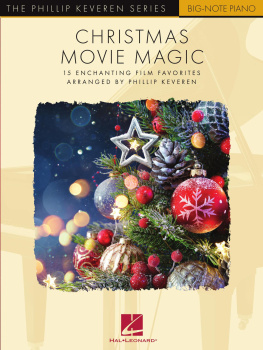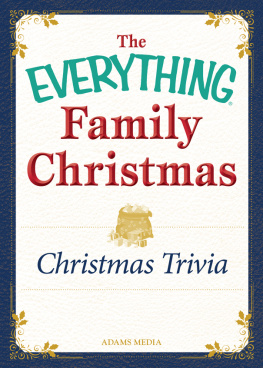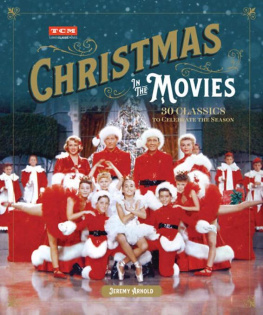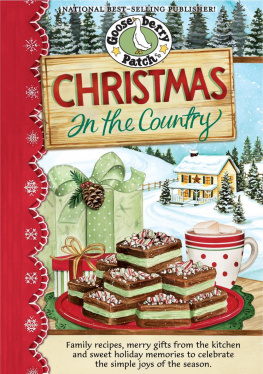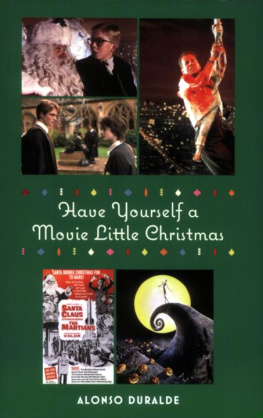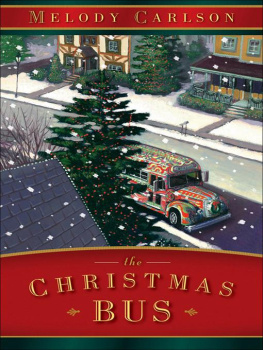The Pilgrim Press, 700 Prospect Avenue East
Cleveland, Ohio 44115-1100
thepilgrimpress.com
2021 John A. Zukowski
All rights reserved. No part of this book may be used or reproduced in any manner whatsoever without written permission.
Published 2021.
In-text artwork and photographs used by permission. Scripture quotations, unless otherwise noted, are from the New Revised Standard Version of the Bible, 1989 by the Division of Christian Education of the National Council of Churches of Christ in the United States of America. Used by permission. Changes have been made for inclusivity.
Printed on acid-free paper.
25 24 23 22 211 2 3 4 5
Library of Congress Cataloging-in-Publication Data on file
Library of Congress Control Number: 2021932642
ISBN 978-0-8298-2122-2 (alk. paper)
ISBN 978-0-8298-2176-5 (ebook)
Printed in The United States of America.
WHAT IS A CHRISTMAS MOVIE?
EVEN AT A YOUNG AGE, I FELT CHRISTMAS WAS CONNECTED TO POP CULTURE.
In an era before home video, I marked the TV Guide so I wouldnt miss A Charlie Brown Christmas, Rudolph The Red-Nosed Reindeer, and How the Grinch Stole Christmas. After I discovered classic Hollywood cinema, I also watched Its a Wonderful Life, The Bishops Wife, and Remember the Night. Christmas wasnt the same if I didnt see them. Recently, when loading them up for another annual viewing, I wanted to figure out why.
It was more than nostalgia. The Hollywood war-era Christmas classics and the TV specials of the 1960s and 1970s portray spiritual awakenings and redemption stories. I saw three common elements in these spiritual conversions: validation of the transcendental, a rejection of materialism, and a move toward community.
But when watching more recent Christmas films I saw a startling difference. Beginning with the Christmas films of the 1980s, instead of spiritual and moral realizations, Christmas movies largely depict how to navigate dysfunctional families during the holiday. And many recent films subvert the traditional Christmas film themes by ignoring the transcendental, embracing materialism, and limiting community to immediate family.
When I researched the Christmas movie genre, I discovered this was largely unnoticed. And there were few serious studies of the Christmas movie genre. So I decided to explore the genre and track its changes over the years.
But first I had to define a Christmas film. By one estimate at least a quarter of the top-grossing films feature Christmas scenes. So how much time must a movie devote to Christmas to be a Christmas movie? About half an hour of Meet Me in St. Louis takes place during the Christmas season. Does that make it a Christmas film? Its a Wonderful Life features most of its action in a flashback that doesnt take place during the Christmas season. So if the standard is the amount of time set during the Christmas season, The Apartmenta movie not usually associated with Christmashas more time devoted to the Christmas season than Its a Wonderful Life. And what about movies such as The Bells of St. Marys and When Harry Met Sally, with key scenes set around Christmas but most of the film not taking place at Christmas?
Movies with Christmas scenes arent full-fledged Christmas filmseven if important scenes or climactic scenes are set during Christmas. A significant portion of a movie must be set during the Christmas season to be a Christmas film. So Meet Me in St. Louis, with a quarter of its running time set on Christmas Eve, is a Christmas film, while The Bells of St. Marys, with just a few Christmas scenes, isnt.
But are all films that devote considerable screen time to the Christmas season actually Christmas movies? Not necessarily. Some movies utilize the Christmas season for the imagery of Christmas, the emotional context associated with it, or simply a plot device to gather characters together. For example, Diner and Just Friends use the Christmas season as a reason for characters to return to their hometown. But the holiday itself isnt adequately integrated into the narrative. Other movies, such as The Thin Man, the film noir Lady in the Lake, and the neo noir Kiss Kiss Bang Bang, use Christmas as an ironic device to contrast associations of home and family with crime or detachment from community.
To be a true Christmas film its necessary that a movie integrate Christmas into the story so the Christmas season affects plot and character development. This means assessing on a case-by-case basis how much impact Christmas has on the characters. In the comedy Diner, Christmas doesnt have a transformative impact. Yet Christmas is transformative to characters in a black comedy such as The Ref and the existentialist crime drama The Ice Harvest. In films such as Lethal Weapon and In Bruges, Christmas is lodged somewhere between being a transformative and non-transformative influence.
The next question is how to define the genre in general. Every year a debate recirculates on the internet about whether Die Hard is a Christmas movie or not. Can an action film be a Christmas film? Despite the consistent iconography of Christmas music, decorations, and imagery used in Christmas films, the Christmas movie genre isnt a separate genre. Christmas films integrate into other genres. Christmas films can be musicals, Westerns, film noir, stoner comedies, crime stories, coming-of-age stories, action moves, as well as comedies and dramas. So, yes, Die Hard is a Christmas film.

Is the action filmLethal Weapon(1987) a Christmas film? In some ways, yes, in some ways, no; this shows the difficulty sometimes in defining a Christmas movie. Courtesy Warner Brothers/Everett Collection.

A Charlie Brown Christmas(1965) is part of the genres Second Wave, which are Christmas TV shows from the 1960s and 1970s. The Christmas film genre is divided into three distinct eras, the first of which started in the World War II years. Courtesy United Features Syndicate/Everett Collection.
Another distinctive feature of Christmas movies is that they are largely grouped together in three specific eras. Thats because Christmas acts as a vehicle to respond to cultural anxieties of those time periods.
This is such a significant element to the genre that this book is organized by these three eras. The First Wave of Christmas movies appeared during the turmoil of the World War II era. The Second Wave emerged on television in the 1960s in the midst of civil unrest and generational clashes. And the Third Wave began in the 1980s in an era of growing materialism.



